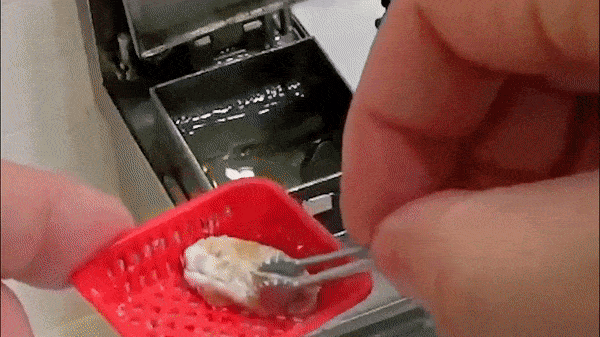KFC is the latest brand to jump on the tiny food craze by opening a miniature restaurant over the weekend. The pop-up location in Portland was open for one day only and offered tiny, edible versions of KFC $5 fill-up boxes free of charge.
Patrons who attended the grand opening of the “World’s Tiniest KFC” had to lay on their bellies to place an order through the restaurant’s front doors. The barely-bite-sized creations included two pieces of fried chicken, mashed potatoes, a biscuit, cookie and Dr. Pepper. Orders were presented by full-sized hands through a curtain in the back of the miniature restaurant.
Those in attendance claimed that the food tasted just like regular-sized portions.
Providing ironically tiny “fill-up” boxes closes out a full year of bizarre marketing for the brand. The quick-service restaurant has built a reputation for unusual marketing efforts—from shooting a sandwich into space to Colonel Sanders romance novels and “internet escape pod” Faraday cages.
This isn’t the first pop-up event for the brand in Portland. “The World’s Tiniest KFC” follows an inflatable KFC erected in the city last year, manned by carolers and a man dressed as Colonel Sanders. Guests were provided with inflatable fried chicken and coupons for free, edible food at a real KFC location.
Tiny food became a phenomenon in 2014 when a YouTube channel called Miniature Space began posting videos of real food being prepared in tiny portions. The videos started a craze in their native Japan, and soon after other countries fell in love with miniature food.
Over 3.8 million people tuned in to watch TasteMade cook tiny food over Facebook Live, and this video of strawberry shortcake has garnered over 10 million views to date. The concept of miniature food presents a familiar aspect of everyday life but in a completely new way.
Crafting tiny versions of familiar recipes is challenging, as well. Recipes are modified to account for a smaller size—substituting quail eggs, for example—and since ovens are heated by a tea light candle, temperatures cannot be adjusted.
Whether KFC will offer tiny food in future activations remains to be seen, but one thing is for sure—the brand isn’t afraid to try something different. Not taking itself too seriously has helped earn the trust of young consumers and at the very least, get noticed. After all, it’s hard to ignore Colonel Sanders wrestling a giant chicken.
“We’ve learned that we need to extend our brand positioning beyond traditional advertising to really break through and make a dent in pop culture,” George Felix, KFC’S director of advertising, told AListDaily. “Our tongue-in-cheek humor and over-the-top selling is something that has been working well for us since many millennials distrust advertising to begin with. Instead of running away from that, we run right toward it. We believe that our ability to poke fun at the conventions of typical advertising has given us credibility with millennials. We know the new brand positioning and advertising have put KFC back on the map.”
Tiny mashed potatoes, tiny fried chicken, tiny biscuit, tiny cookie, tiny Dr. Pepper. These are just a few of the tiny things you’ll find if you come to the tiny grand opening of the World’s Tiniest KFC on 12/16…if you can find it. pic.twitter.com/czvs4ZtS82
— KFC (@kfc) December 14, 2017

